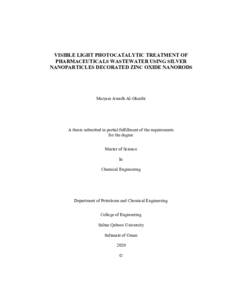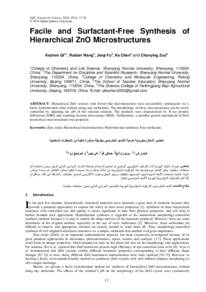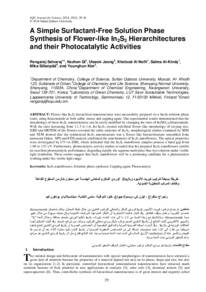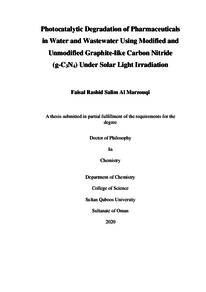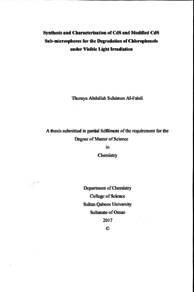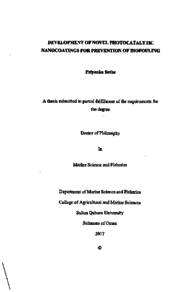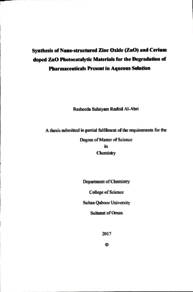Document
Visible light photocatalytic treatment of pharmaceuticals wastewater using silver nanoparticles decorated zinc oxide nanorods.
Identifier
Al-Gharibiyah, Maryam Awadh (2020). Visible light photocatalytic treatment of pharmaceuticals wastewater using silver nanoparticles decorated zinc oxide nanorods (Master thesis, Sultan Qaboos University, Muscat, Oman).
Publisher
Sultan Qaboos University.
Gregorian
2020
Language
English
English abstract
Pharmaceutical compounds in wastewater are a concerning issue. Pharmaceutical wastes
cause harmful effects even at low concentrations. This thesis is to investigate the
degradation of the pharmaceutical wastes by the photocatalysis process using silver
nanoparticles (Ag NPs) decorated zinc oxide (ZnO) nanorods. ZnO nanorods were first
synthesized on glass substrate by microwave hydrothermal method. Silver nanoparticles
were subsequently deposited on ZnO nanorods by photodeposition technique. Different
concentrations of silver nitrate were used and optimized. In addition, effect of annealing
temperatures and environments upon silver nanoparticles formation on ZnO NRs were
investigated. The synthesized Ag-ZnO nanostructures were characterized by X-ray
diffraction (XRD), field emission scanning electron microscopy (FE-SEM), energy
dispersive X-ray analysis (EDXA), transmission electron microscopy (TEM), X-ray
photoelectron spectroscopy (XPS), UV-visible absorption spectroscopy (UV-Vis), and
photoluminescence (PL) spectroscopy. XRD, FE-SEM and TEM results confirm that
ZnO nanorods have hexagonal wurtzite crystal structure with Ag nanoparticles were
successfully attached on ZnO nanorods. XPS results confirm the presence of metallic
silver in Ag-ZnO nanostructures. PL results provide an effective separation of
photogenerated electron-hole pairs in the Ag-ZnO nanostructures when compared to the
pristine ZnO nanorods. UV-visible absorption spectroscopy shows enhance optical
absorption in the visible region due to the surface plasmon resonance properties of Ag
nanoparticles. The Ag-ZnO nanostructures were used as catalysts for the
photodegradation of pharmaceutical compounds (paracetamol and amoxicillin). The
photocatalysis results exhibit Ag-ZnO nanostructures have higher degradation than
pristine ZnO nanorods where Ag-ZnO catalysts degrade 92 % of 5 ppm paracetamol
than ZnO (47% degradation) under visible light irradiation. For 10 ppm amoxicillin,
around 67% of degradation using Ag-ZnO catalysts and about 46 using ZnO catalysts.
Member of
Resource URL
Arabic abstract
وجود المركبات الدوائية في مياه الصرف الصحي يعتبر قضية مثيرة للقلق، وتسبب بقايا المستحضرات الدوائية آثارا ضارة حتى وان كانت بتركيزات منخفضة. تهدف األطروحة الى تكسير المركبات الدوائية في مياه الصرف الصحي باستخدام أعمدة أكسيد الزنك النانوية المزينة بالفضة. تم تصنيع أعمدة أكسيد الزنك باستخدام الطريقة المائية الحرارية بينما تم تصنيع جزيئات الفضة على أسطح أعمدة أكسيد الزنك باستخدام تقنية الترسيب الضوئي لخالت الفضة. تم اختيار التركيز األفضل لعدد جزيئات الفضة النانوية على سطح أكسيد الزنك من خالل تغيير التركيز خالت الفضة أثناء الترسيب على أعمدة أكسيد الزنك. وكذلك تم اختيار درجة حرارة التلدين الأمثل من خالل تغيير درجة الفرن. لقد تم تحليل المواد الناتجة باستخدام تقنيات حيود األشعة السينية، والمجاهر االلكترونية، ومطيافية تشتت الطاقة باألشعة السينية، والمجهر اإللكتروني النافذ، ومطيافية األشعة السينية الضوئية مطيافية األشعة المرئية وفوق البنفسجية، ونظام التحليل الطيفي الضوئي. وتحليل حيود األشعة السينية والمجاهر االلكترونية والمجهر اإللكتروني النافذ إلثبات وجود البنية البلورية السداسية للزنك مرتبط مع جزيئات الفضة النانوية. وتحليل مطيافية األشعة السينية الضوئي يثبت وجود جسيمات الفضة النانوية في هياكل أكسيد الزنك النانوية غير المتجانسة. ويظهر نظام التحليل الطيفي الضوئي فعالية فصل أزواج الثقوب اإللكترونية المتولدة ضوئيًا في أعمدة أكسيد الزنك مع جزيئات الفضة بالمقارنة مع عينات أكسيد الزنك البدائي. كما يُظهر مطياف األشعة المرئية وفوق البنفسجية تحسن في االمتصاص البصري في المنطقة المرئية بسبب بخاصية الرنين السطحية للجزيئات الفضة. لقد تم عمل تجارب التكسير الضوئي للمركبات الدوائية )الباراسيتامول واألموكسيسيلين( من خالل استخدام أكسيد الزنك البدائي وأكسيد الزنك المزخرف بجزيئات الفضة. تظهر نتائج التحفيز الضوئي ل 5 مجم لكل لتر من الباراسيتامول أن الهياكل النانوية ألكسيد الزنك المزخرف بالفضة أكثر انحلال من عينة أكسيد الزنك البدائي، حيث وجد أن 92 %من المادة الدوائية قد تم تكسيرها عند استخدام أعمدة أكسيد الزنك مع الفضة مقارنة ب 53 %عند استخدام أكسيد الزنك البدائي. بالنسبة لـ 10 مجم لكل لتر من أموكسيسيلين، حوالي 67 ٪من التحلل باستخدام محفزات الهياكل النانوية لأكسيد الزنك المزخرف بالفضة وحوالي 46 باستخدام محفزات أكسيد الزنك البدائي.
Category
Theses and Dissertations

